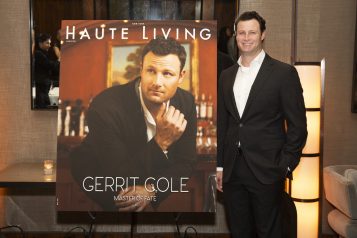Tad Taube entered the American workforce almost 70 years ago when he first stepped in front of a camera for a role in a feature film. He played an immigrant child who was bullied by the neighborhood kids during an epic pickup baseball game. The character prevailed over the adversity, and hit the game-winning homerun, thus also winning over the affections of his contemporaries.
It’s a common tale that has had many reincarnations throughout cinematic history. The reason for the story’s prevalence is because it so often mirrors real life; in fact, it could be used as a sweeping synopsis of the life of that former child actor himself.
Taube was born in Poland in 1931, a child of a middle- to upper-class family. But when the Nazi invasion took place, his family and foundation were rocked to the core, and they eventually immigrated to the United States, settling first in New York before moving west to Los Angeles, which is where he got his early start in the film industry. It was the first of many careers, all of which would teach Taube invaluable life and business lessons that are being applied today in his work at his three San Francisco-based philanthropies dedicated to the benefit of Bay Area communities and Israel, the Koret Foundation and his two Taube Foundations.
After attending Stanford, war once again shaped his life path. The Korean War was raging, and Taube was eligible for the draft. A deferment was available for engineering students, so he opted to enter the program. In graduate school, Taube pursued a degree in industrial management, a hybrid program between the engineering and business schools. Upon graduation, a career venture that included installing heating equipment piqued his interest in the real estate market. “There were a lot of programs being offered by utility companies that provided incentives to builders to have all gas or all electric homes,” he states. “I was actually in charge of those programs, and learned a lot about the building process, so I started constructing apartment buildings while I was still employed in other pursuits.”
He built a successful real estate empire throughout the San Francisco Bay area, which attracted the attention of the impressive Joe Koret, whom Taube describes as “like me, the beneficiary of the American Dream.” Koret’s family had immigrated to the U.S. from Eastern Europe. Along with his wife Stephanie, Joe owned and operated an apparel company, Koret of California, which was responsible for the development of the first permanent press process. The innovation was a lucrative advancement for the Korets, who began to search for investment opportunities for their newfound wealth. This was when they encountered Taube.
In Tad Taube, they found a worthy advisor and confidant; in the Korets, Taube found lifelong friends and a source of inspiration. “We got to be very close,” Taube explains. “I became part of their extended family, and I really think it’s safe to say that I became involved in every aspect of their lives.” This is especially true for the business aspects. Koret of California evolved into Koracorp Industries, and Taube assumed a role on the board of directors. When the firm hit some rocky financial roads, Taube stepped in as the company’s CEO. While it may have seemed like a risky choice to appoint a real estate professional with the daunting task of turning around a floundering international textile and apparel company, his business background provided him with the skills to know how to handle the situation. A few years (and a bit of legal entanglement with the FCC) later, Koracorp was once again in the black. Exhausted from the arduous climb back to the top, Taube planned a group exit for the Korets and himself from the fashion conglomerate that resulted in a fruitful merger with Levi Strauss & Co.
While the reason for his exit from the apparel industry was to free up time to once again focus on his main passion—real estate—Taube says it wasn’t long before he was “bitten a little bit by the diversity bug.”
This was at the same time that his friend, the late real estate developer Jim Joseph, was helping to develop the now-defunct United States Football League. Taube and Joseph were involved in the planning stages of the spring and summer league, which was to have 12 teams. Taube’s well-honed business eye immediately saw the profitable possibilities of the USFL. “I joined Jim and started going to league meetings, started to get to know the other owners. I started becoming familiar with the business plan, and became intrigued with what I thought was a positive plan. I felt it had a very high chance of success.”
The USFL was announced to the American public during a highly televised press conference at Club 21 in New York City. The evening was presided over by the late Howard Cosell, who later became the voice of Monday Night Football for the NFL. More than a dozen television cameras were trained on the U-shaped table that had 12 seats for the owners. “However, I learned the night before that we only had 11 owners,” recalls Taube. “And that’s not good if you’re going to do a national media blitz announcing a new league!”
The owners prevailed upon Taube to fill the 12th seat for the initial conference as a temporary solution. Upon landing back in San Francisco following the announcement, it quickly became apparent his role was not going to be a fleeting one. “There were at least 50 cameramen with flashbulbs going off in my face, wanting to meet this new Bay Area owner of the local franchise. There was intense interest and publicity at the time. I was locked in at that point—there was no graceful way out.”
The league was launched to provide football fans with their pigskin fix when the NFL was in offseason. For the entire three-year duration of its existence, Taube served as the owner of the Oakland Invaders. The league eventually dissolved, but Taube was involved from inception through the end.
If he was hesitant at the beginning of the USFL to take on a full-time role, it was because he had his hands full with a venture that occupies him to this day. Joe Koret’s wife Stephanie had passed in 1979, and the couple’s communal property and assets were extremely high. During this trying time, Taube and Joe were attempting to preclude the government from taking a large chunk of the fortune in death taxes (at the time, the laws would have left Joe with a mere 25 percent of her estate). Because the Korets had no children, the decision was made to let her estate pass into a charitable trust, The Koret Foundation, which today benefits Bay Area communities, as well as Israel. “When Stephanie’s share went into the Koret Foundation, very significant assets in the range of $40 to $50 million were passed, which was the initial corpus of the Koret Foundation.”
Taube, estate planning attorney Richard Greene, Eugene Friend, and Stanley Herzstein were the initial founding directors, and were eventually joined by Joe’s second wife Susan. Joe worked as the foundation’s first chairman until his death in 1982, at which time his portion of the family’s estate also flowed into the foundation and Taube assumed the role of president and CEO. Under his watchful eye, the foundation’s assets ballooned from $100 million at the time of Joe’s death to more than $400 million today.
Taube’s ample business experience provided him with a strong basis for running the philanthropy, but he does say that it is a complicated field. “Initially there is a lot of excitement about having the ability to give away all of this money, but you learn pretty quickly that actually earning it may be easier than giving it away intelligently.”
Inspired by his work with the Koret Foundation, Taube launched the Taube Family Foundation and, more recently, the Taube Foundation for Jewish Life and Culture. Explaining the relationship between the three foundations, he says, “I learned a lot from the Koret Foundation. It gave me a model—an example—of what could be done.” The foundations’ missions intersect often, and these are collaborations that allow them to accomplish more than if they were trying to make a difference separately. “The whole philanthropic process doesn’t function unless the project funded has a significant impact,” he explains. “And the way that you tend to get impact more often—although I am not suggesting this is the only way—is by the amount of funding that you can commit. So by having collaborative relationships with other funders and philanthropies, the partners in those collaborations each gain a greater level of impact than they could achieve by themselves.”
One of the joint projects that is making quite the impact is the Taube Koret Campus for Jewish Life in Palo Alto. The center is a multigenerational destination where individuals and families can live, learn, play, and connect. “It’s probably the largest Jewish project ever conceived in Northern California….It pretty much spans the gamut of Jewish communal life. The Koret and Taube philanthropies each made a $10 million commitment to that project, and we are the lead donors with a combined commitment of $20 million.” They are also teaming up with significant commitments to the Contemporary Jewish Museum in San Francisco, the Hoover Institution at Stanford University, and the California Academy of Sciences in Golden Gate Park.
Taube is able to pursue his own passions through the Taube Foundations, and he gets most excited when speaking of the work on the renaissance of Jewish culture and life in his native Poland, much of which was eradicated during the Nazi invasion in 1939. To help restore the culture’s 1,000-year history in the area, the Taube and Koret foundations are involved in building what will be one of the most important Jewish museums in the world—The Museum of the History of Polish Jews, in Warsaw, Poland. “It will not be a Holocaust museum; it will be dedicated to that golden era of Jewish history, that 1,000 years that did so much to shape Western culture.”
Taube’s life story is most certainly an example of the American Dream. He came to the U.S. while dire circumstances raged in his homeland, but was able to persevere and grow elaborate careers in a variety of fields. But he never forgot his roots; the latest chapter in his long life has been dedicated to the betterment of his native people, which helps complete his circle of life.


















